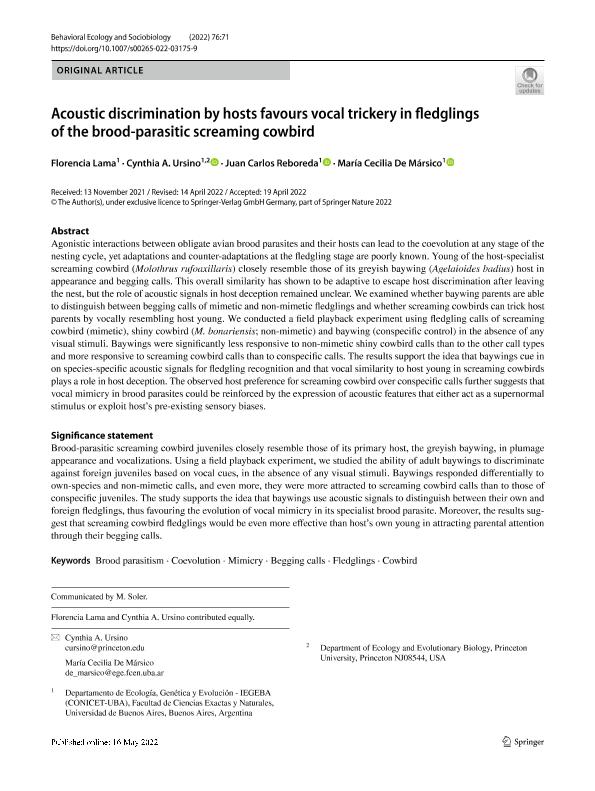Mostrar el registro sencillo del ítem
dc.contributor.author
Lama, Florencia

dc.contributor.author
Ursino, Cynthia Alejandra

dc.contributor.author
Reboreda, Juan Carlos

dc.contributor.author
de Marsico, Maria Cecilia

dc.date.available
2023-10-03T09:59:27Z
dc.date.issued
2022-05
dc.identifier.citation
Lama, Florencia; Ursino, Cynthia Alejandra; Reboreda, Juan Carlos; de Marsico, Maria Cecilia; Vocal trickery allows specialist screaming cowbird juveniles to escape host discrimination after leaving the nest; Springer; Behavioral Ecology And Sociobiology; 76; 5; 5-2022; 1-11
dc.identifier.issn
0340-5443
dc.identifier.uri
http://hdl.handle.net/11336/213860
dc.description.abstract
Agonistic interactions between obligate avian brood parasites and their hosts can lead to the coevolution at any stage of the nesting cycle, yet adaptations and counter-adaptations at the fledgling stage are poorly known. Young of the host-specialist screaming cowbird (Molothrus rufoaxillaris) closely resemble those of its greyish baywing (Agelaioides badius) host in appearance and begging calls. This overall similarity has shown to be adaptive to escape host discrimination after leaving the nest, but the role of acoustic signals in host deception remained unclear. We examined whether baywing parents are able to distinguish between begging calls of mimetic and non-mimetic fledglings and whether screaming cowbirds can trick host parents by vocally resembling host young. We conducted a field playback experiment using fledgling calls of screaming cowbird (mimetic), shiny cowbird (M. bonariensis; non-mimetic) and baywing (conspecific control) in the absence of any visual stimuli. Baywings were significantly less responsive to non-mimetic shiny cowbird calls than to the other call types and more responsive to screaming cowbird calls than to conspecific calls. The results support the idea that baywings cue in on species-specific acoustic signals for fledgling recognition and that vocal similarity to host young in screaming cowbirds plays a role in host deception. The observed host preference for screaming cowbird over conspecific calls further suggests that vocal mimicry in brood parasites could be reinforced by the expression of acoustic features that either act as a supernormal stimulus or exploit host’s pre-existing sensory biases. Significance statement: Brood-parasitic screaming cowbird juveniles closely resemble those of its primary host, the greyish baywing, in plumage appearance and vocalizations. Using a field playback experiment, we studied the ability of adult baywings to discriminate against foreign juveniles based on vocal cues, in the absence of any visual stimuli. Baywings responded differentially to own-species and non-mimetic calls, and even more, they were more attracted to screaming cowbird calls than to those of conspecific juveniles. The study supports the idea that baywings use acoustic signals to distinguish between their own and foreign fledglings, thus favouring the evolution of vocal mimicry in its specialist brood parasite. Moreover, the results suggest that screaming cowbird fledglings would be even more effective than host’s own young in attracting parental attention through their begging calls.
dc.format
application/pdf
dc.language.iso
eng
dc.publisher
Springer

dc.rights
info:eu-repo/semantics/openAccess
dc.rights.uri
https://creativecommons.org/licenses/by-nc-sa/2.5/ar/
dc.subject
BEGGING CALLS
dc.subject
BROOD PARASITISM
dc.subject
COEVOLUTION
dc.subject
COWBIRD
dc.subject
FLEDGLINGS
dc.subject
MIMICRY
dc.subject.classification
Zoología, Ornitología, Entomología, Etología

dc.subject.classification
Ciencias Biológicas

dc.subject.classification
CIENCIAS NATURALES Y EXACTAS

dc.title
Vocal trickery allows specialist screaming cowbird juveniles to escape host discrimination after leaving the nest
dc.type
info:eu-repo/semantics/article
dc.type
info:ar-repo/semantics/artículo
dc.type
info:eu-repo/semantics/publishedVersion
dc.date.updated
2023-07-07T22:28:23Z
dc.journal.volume
76
dc.journal.number
5
dc.journal.pagination
1-11
dc.journal.pais
Alemania

dc.journal.ciudad
Berlin
dc.description.fil
Fil: Lama, Florencia. Universidad de Buenos Aires. Facultad de Ciencias Exactas y Naturales. Departamento de Ecología, Genética y Evolución; Argentina
dc.description.fil
Fil: Ursino, Cynthia Alejandra. Consejo Nacional de Investigaciones Científicas y Técnicas. Oficina de Coordinación Administrativa Ciudad Universitaria. Instituto de Ecología, Genética y Evolución de Buenos Aires. Universidad de Buenos Aires. Facultad de Ciencias Exactas y Naturales. Instituto de Ecología, Genética y Evolución de Buenos Aires; Argentina
dc.description.fil
Fil: Reboreda, Juan Carlos. Consejo Nacional de Investigaciones Científicas y Técnicas. Oficina de Coordinación Administrativa Ciudad Universitaria. Instituto de Ecología, Genética y Evolución de Buenos Aires. Universidad de Buenos Aires. Facultad de Ciencias Exactas y Naturales. Instituto de Ecología, Genética y Evolución de Buenos Aires; Argentina
dc.description.fil
Fil: de Marsico, Maria Cecilia. Consejo Nacional de Investigaciones Científicas y Técnicas. Oficina de Coordinación Administrativa Ciudad Universitaria. Instituto de Ecología, Genética y Evolución de Buenos Aires. Universidad de Buenos Aires. Facultad de Ciencias Exactas y Naturales. Instituto de Ecología, Genética y Evolución de Buenos Aires; Argentina
dc.journal.title
Behavioral Ecology And Sociobiology

dc.relation.alternativeid
info:eu-repo/semantics/altIdentifier/doi/http://dx.doi.org/10.1007/s00265-022-03175-9
Archivos asociados
